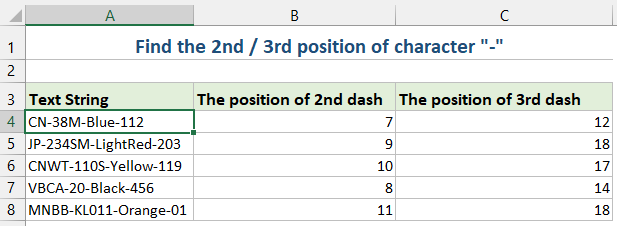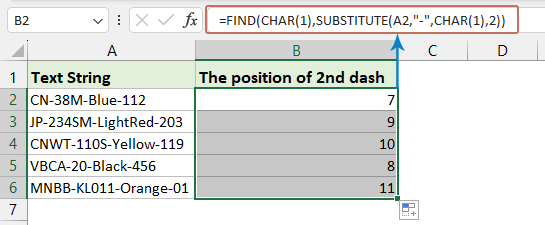Temukan kemunculan karakter ke-n di Excel – 3 cara cepat
Menemukan kemunculan karakter tertentu dalam string teks di Excel bisa sangat berguna dalam analisis data, di mana Anda mungkin perlu mengurai string atau mengekstrak informasi berdasarkan pembatas atau pola tertentu. Misalnya, cari kemunculan karakter "-" ke-2 atau ke-3 dalam string teks. Saya akan mendemonstrasikan teknik sederhana untuk menyelesaikan tugas ini secara efisien.

Temukan kemunculan karakter ke-n dalam string teks dengan rumus
Anda dapat membuat rumus untuk menemukan kemunculan karakter yang ke-n. Silakan lakukan seperti ini:
1. Masukkan atau salin rumus berikut ke dalam sel tempat Anda ingin mendapatkan hasilnya:
=FIND(CHAR(1),SUBSTITUTE(A2,"-",CHAR(1),2))- A2: Sel yang berisi string.
- -: Karakter yang Anda cari.
- 2: Kemunculan ke-2 yang ingin dicari, dapat diubah menjadi 3,4…sesuai kebutuhan.
2. Kemudian, seret isian rumus ke bawah untuk mengisi rumus ke sel lain, dan posisi ke-2 karakter – ditampilkan sekaligus, lihat tangkapan layar:
- PENGGANTI menggantikan kemunculan karakter ke-n dengan karakter yang tidak dapat dicetak (CHAR(1)).
- MENCARI mencari karakter yang tidak dapat dicetak ini, memberikan posisi kejadian ke-n.
Temukan kemunculan karakter ke-n dalam string teks dengan Kutools for Excel
Jika Anda bukan penggemar menggunakan formula atau VBA, Anda mungkin mempertimbangkan alternatif yang mudah – Kutools untuk Excel. Dalam grup Formulanya, Anda akan menemukan utilitas yang berguna – Temukan di mana karakter muncul ke-N dalam sebuah string yang dengan cepat mengidentifikasi dan mengembalikan posisi ke-n dari karakter mana pun dalam sel.
Setelah menginstal Kutools untuk Excelklik Kutools > Pembantu Formula > Pembantu Formula untuk membuka Pembantu Formula kotak dialog. Klik sel tempat Anda ingin meletakkan hasilnya. Kemudian, lakukan hal berikut:
- Pilih Lookup dari daftar drop-down Jenis Formula bagian;
- Pilih Temukan di mana karakter muncul ke-N dalam sebuah string in Pilih rumus bagian;
- Pilih sel yang berisi string yang Anda gunakan, lalu ketikkan karakter yang ditentukan dan kejadian ke-n ke dalam kotak teks di Masukan argumen bagian;
- Terakhir, klik OK tombol untuk mendapatkan hasilnya.

Temukan kemunculan karakter ke-n dalam string teks dengan Fungsi Buatan Pengguna
Di bagian ini, kita akan mempelajari cara membuat dan menggunakan UDF untuk menemukan kemunculan karakter ke-n di Excel, memberikan panduan langkah demi langkah untuk membantu Anda mengoptimalkan penanganan data Anda.
- Tahan ALT + F11 kunci, dan itu membuka Microsoft Visual Basic untuk Aplikasi jendela.
- Klik Menyisipkan > Modul, dan tempelkan makro berikut di Jendela Modul.
Function FindN(sFindWhat As String, _ sInputString As String, N As Integer) As Integer 'Updateby Extendoffice Dim J As Integer Application.Volatile FindN = 0 For J = 1 To N FindN = InStr(FindN + 1, sInputString, sFindWhat) If FindN = 0 Then Exit For Next End Function - Kemudian, tutup jendela vba. Kembali ke lembar kerja, masukkan rumus berikut ke dalam sel, lalu seret gagang isian ke bawah untuk mengisi rumus ke sel lain, lihat tangkapan layar:
=FindN("-",A2,3)
- Hitung jumlah kemunculan suatu kata dalam satu kolom
- Jika Anda memiliki data kolom yang menyertakan beberapa nilai duplikat seperti gambar di bawah ini yang ditampilkan, dan sekarang yang ingin Anda lakukan adalah menghitung jumlah kemunculan kata tertentu di kolom ini. Sekarang dengan tutorial ini, saya memperkenalkan beberapa trik untuk menyelesaikannya dengan cepat di Excel.
- Ganti n karakter pertama atau kemunculan karakter ke-n dengan yang lain
- Di Excel, kami biasanya menemukan dan mengganti string dengan fungsi Temukan dan Ganti, tetapi jika Anda berada dalam salah satu kasus di bawah ini, fungsi Temukan dan Ganti tidak dapat membantu Anda.
- Ekstrak karakter ke-n dari sebuah string
- Secara umum, Anda mungkin ingin mengekstrak string setelah karakter tertentu, tetapi dalam kasus ini, saya ingin mengekstrak karakter ke-n dari string seperti gambar di bawah ini.
- Ekstrak n karakter pertama/terakhir dari string
- Misalnya, ada daftar dengan string panjang di setiap sel, dan Anda ingin mengekstrak karakter n pertama dari setiap string saja, seperti 3 karakter pertama dari setiap string, dan sekarang Anda dapat menggunakan metode berikut untuk menyelesaikannya di Excel .
Artikel Terkait:
Alat Produktivitas Kantor Terbaik
Tingkatkan Keterampilan Excel Anda dengan Kutools for Excel, dan Rasakan Efisiensi yang Belum Pernah Ada Sebelumnya. Kutools for Excel Menawarkan Lebih dari 300 Fitur Lanjutan untuk Meningkatkan Produktivitas dan Menghemat Waktu. Klik Di Sini untuk Mendapatkan Fitur yang Paling Anda Butuhkan...

Tab Office Membawa antarmuka Tab ke Office, dan Membuat Pekerjaan Anda Jauh Lebih Mudah
- Aktifkan pengeditan dan pembacaan tab di Word, Excel, PowerPoint, Publisher, Access, Visio, dan Project.
- Buka dan buat banyak dokumen di tab baru di jendela yang sama, bukan di jendela baru.
- Meningkatkan produktivitas Anda sebesar 50%, dan mengurangi ratusan klik mouse untuk Anda setiap hari!
